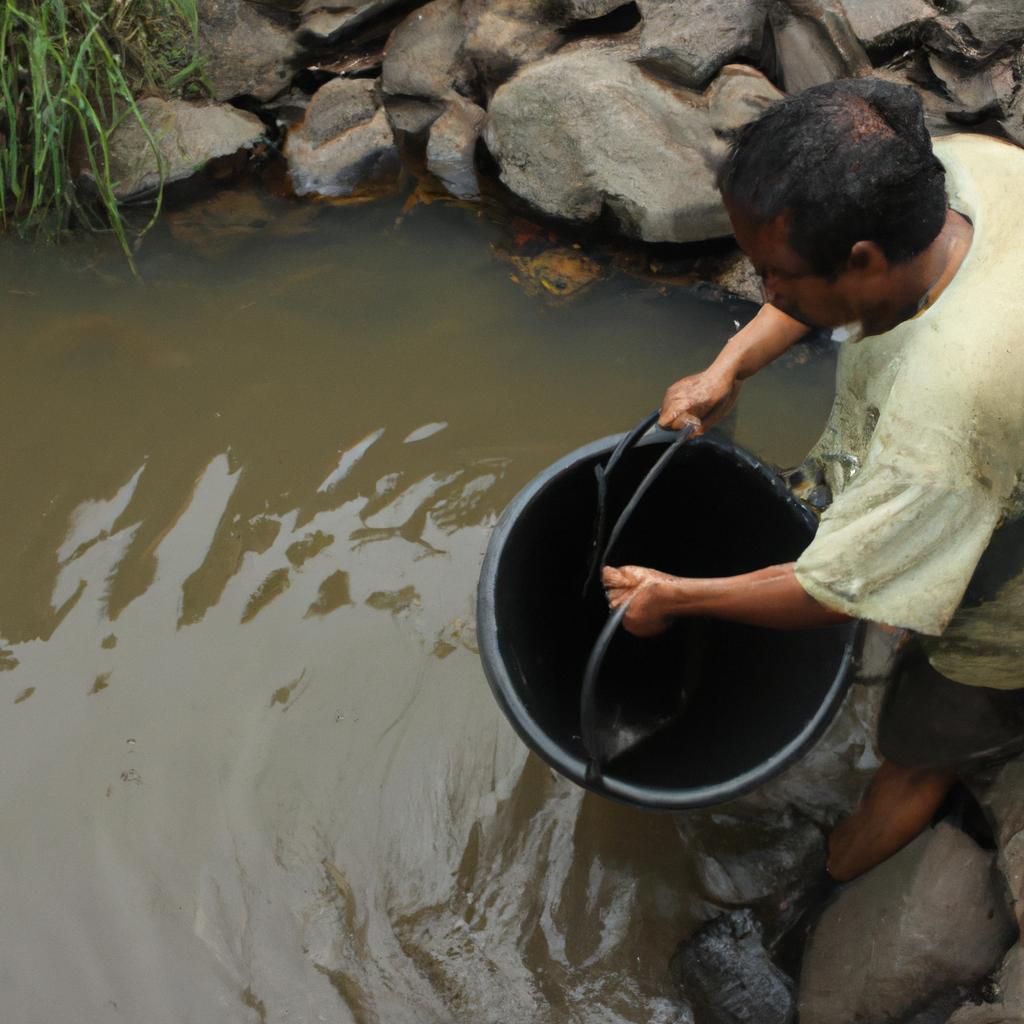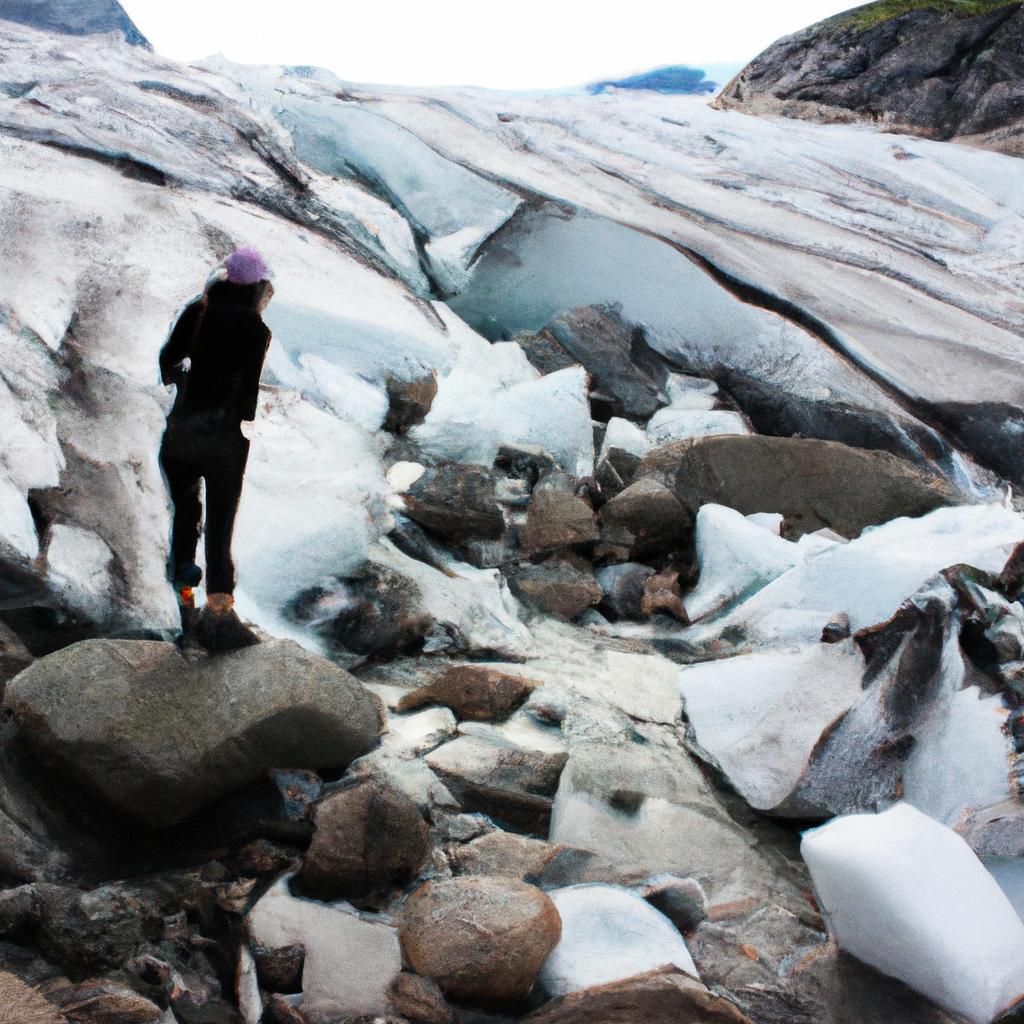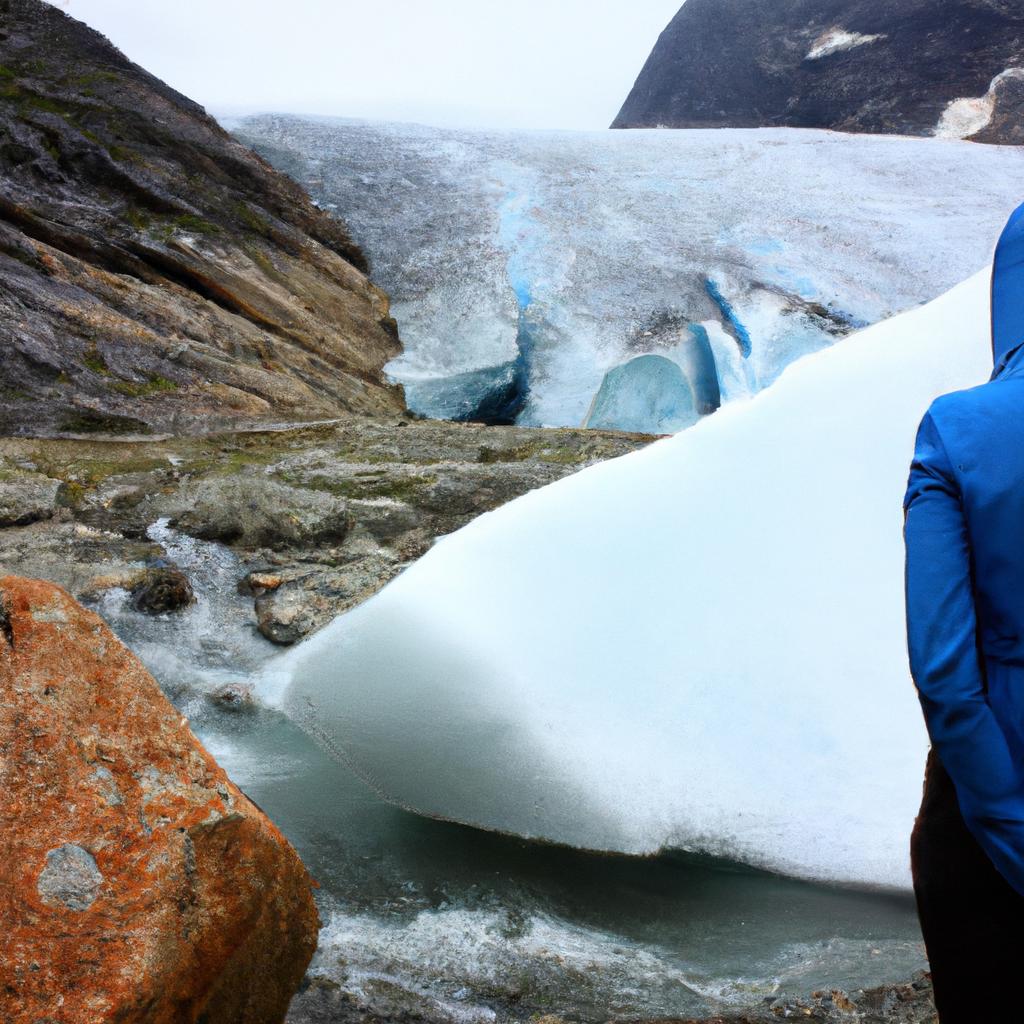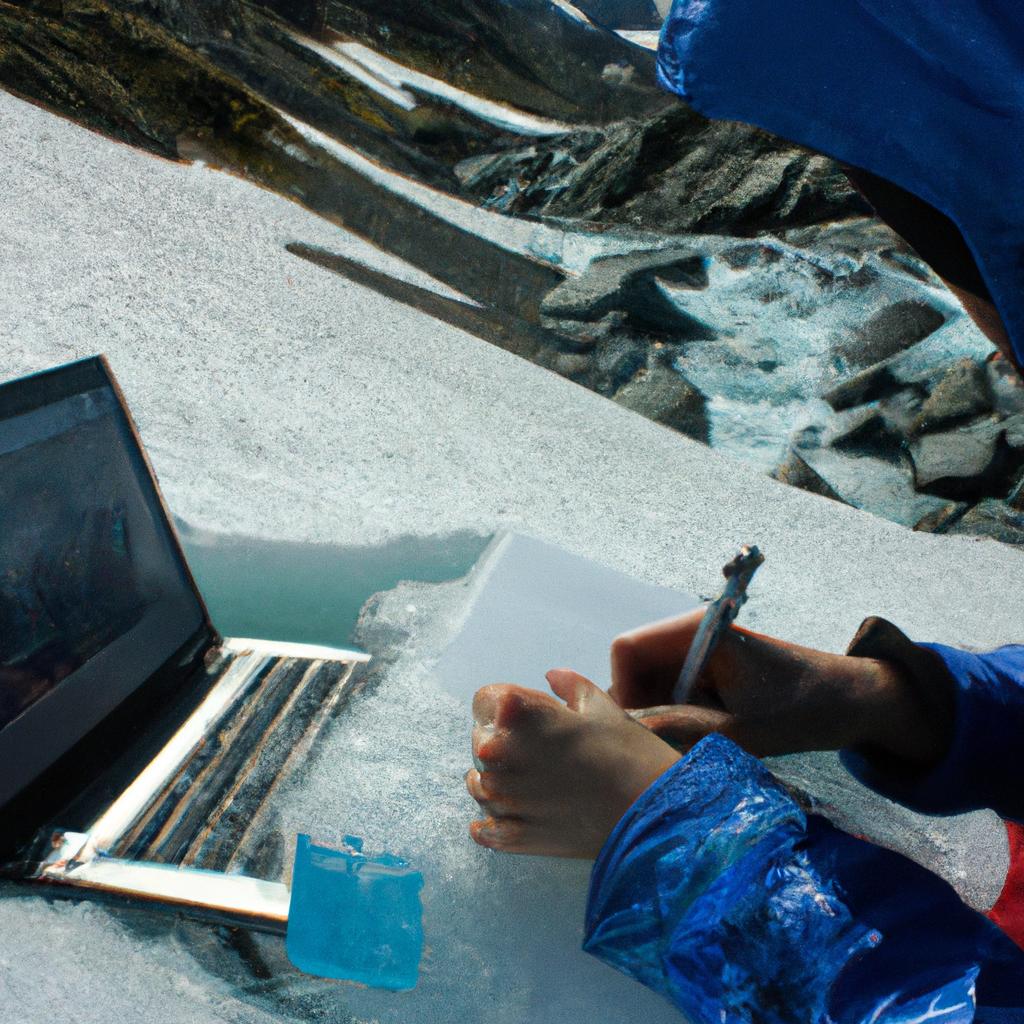Climate change poses a significant threat to the world’s freshwater sources, particularly through the accelerated melting of glaciers. This phenomenon has already been observed in various regions across the globe and is projected to worsen in the coming decades. For instance, let us consider the case study of Glacier National Park located in Montana, United States. Over the past century, this once majestic park has seen a dramatic reduction in its glacier coverage from around 150 glaciers to fewer than 30 today. This decline not only affects the aesthetic beauty of the park but also has far-reaching implications for downstream water resources that rely on glacial meltwater as their primary source.
The melting of glaciers due to climate change exacerbates global water scarcity by disrupting natural hydrological processes. Glaciers act as reservoirs of freshwater, storing immense quantities of frozen water over long periods. As they melt at an accelerated rate, these vast reserves are released into rivers and streams, contributing significantly to overall freshwater availability during dry seasons or droughts. However, with rising temperatures caused by climate change, glaciers are experiencing rapid shrinkage and retreat worldwide. Consequently, this process disrupts regional water cycles and threatens the stability of ecosystems and human livelihoods dependent on reliable water supplies.
In light of these alarming trends In light of these alarming trends, it is crucial to take immediate and concerted action to mitigate the impacts of climate change on freshwater sources. This includes reducing greenhouse gas emissions to limit further warming and implementing adaptation strategies to ensure water security for communities affected by glacier retreat.
Some possible measures that can be taken include:
-
Implementing sustainable water management practices: This involves promoting efficient water use, investing in water infrastructure development, and adopting technologies that reduce water loss through leakage or evaporation.
-
Promoting conservation and restoration of ecosystems: Protecting and restoring natural habitats such as wetlands and forests helps maintain healthy hydrological cycles, improving water quality and availability.
-
Enhancing monitoring systems: Investing in robust monitoring networks enables better understanding of changing hydrological patterns, facilitating timely responses and adaptive management strategies.
-
Diversifying water sources: Developing alternative sources of freshwater such as desalination plants, rainwater harvesting systems, or wastewater reuse projects can help alleviate pressure on dwindling glacial meltwater supplies.
-
Raising awareness and education: Informing the public about the importance of freshwater conservation and the link between climate change and glacier melting can encourage individual actions towards more sustainable lifestyles.
Addressing the challenges posed by climate change requires global cooperation and collaboration among governments, organizations, communities, and individuals. By collectively working towards a more sustainable future, we can strive to protect our freshwater sources for present and future generations.
Impacts of rising temperatures on freshwater sources
Impacts of Rising Temperatures on Freshwater Sources
Rising temperatures caused by climate change have significant consequences for freshwater sources worldwide. One example that illustrates this threat is the melting glaciers in the Himalayas, which provide water to millions of people in Asia. As temperatures continue to rise, it is crucial to understand the potential impacts on freshwater availability and quality.
The first major impact of rising temperatures on freshwater sources is the accelerated melting of glaciers. Glaciers act as natural reservoirs, storing vast amounts of freshwater over long periods. However, with increasing global temperatures, these glaciers are rapidly retreating and losing their mass. This phenomenon not only diminishes the available freshwater supply but also leads to an imbalance in ecosystems dependent on glacial meltwater.
Additionally, higher temperatures can exacerbate water scarcity issues by intensifying evaporation rates from lakes and rivers. As water bodies lose more moisture through evaporation, their overall volume decreases, making them less reliable as a source of freshwater. This trend poses a severe challenge for regions already grappling with limited water resources.
Furthermore, rising temperatures contribute to changes in precipitation patterns, leading to more frequent droughts or intense rainfall events. These erratic weather conditions affect both surface and groundwater recharge processes, disrupting the replenishment of vital freshwater sources. Consequently, communities relying on such sources face heightened risks concerning food security, livelihoods, and public health.
To emphasize the emotional impact of these challenges posed by rising temperatures on freshwater sources due to climate change:
- The loss of glacial meltwater threatens not only human populations but also unique biodiversity hotspots.
- Scarce water resources aggravate socio-economic disparities and increase conflicts over access to clean drinking water.
- Droughts and floods resulting from changing precipitation patterns disrupt agricultural productivity and lead to potential crop failures.
- Impaired water quality due to reduced flow and increased pollution levels directly affects human well-being.
Table: Impacts of Rising Temperatures on Freshwater Sources
| Impact | Description |
|---|---|
| Melting glaciers | Diminished freshwater supply, imbalance in ecosystems dependent on glacial meltwater |
| Intensified evaporation | Higher rates of moisture loss from lakes and rivers, leading to decreased water availability |
| Altered precipitation patterns | More frequent droughts or intense rainfall events, affecting surface and groundwater replenishment |
In light of these challenges, understanding the role of glaciers in freshwater supply becomes crucial. By comprehending how changes in glacier dynamics impact downstream communities, policymakers can better address the potential consequences and develop effective adaptation strategies.
Transitioning into the subsequent section about “The Role of Glaciers in Freshwater Supply,” it is important to delve deeper into examining their significance as natural water storage systems and explore how their depletion affects overall freshwater resources.
The role of glaciers in freshwater supply
Transition: Having explored the impacts of rising temperatures on freshwater sources, it is crucial to examine the role that glaciers play in sustaining these valuable resources. Glaciers are not only majestic natural wonders but also vital contributors to our ecosystems. Their melting due to climate change poses a significant threat to global freshwater supplies.
The Role of Glaciers in Freshwater Supply
Glaciers serve as massive reservoirs of freshwater, storing around 69% of the world’s total supply. They act as reliable water sources for numerous rivers and lakes, supporting diverse aquatic ecosystems and providing sustenance for both humans and wildlife. For instance, let us consider the case study of the Himalayan glaciers which feed major river systems such as the Ganges and Indus rivers. The meltwater from these glaciers significantly contributes to agricultural productivity, drinking water availability, hydropower generation, and overall economic development across South Asia.
To fully comprehend the vulnerability we face with shrinking glaciers, here are some key points:
- Melting Rate: Glacial melt rates have accelerated over recent decades due to increasing global temperatures.
- Water Availability: Reduced glacier mass leads to decreased water storage capacity during dry seasons or extended periods of drought.
- Ecosystem Disruption: Melting glaciers alter streamflow patterns, impacting downstream communities and disrupting delicate ecological balances.
- Sea-Level Rise: As glacial ice melts into oceans, it contributes directly to sea-level rise worldwide.
| Impact | Description |
|---|---|
| Water Scarcity | Diminished glacier runoff affects access to clean drinking water and irrigation opportunities |
| Biodiversity Loss | Changes in streamflow disrupt habitats leading to loss of species diversity |
| Economic Consequences | Impacts on hydroelectric power generation affect energy security and regional economies |
In light of these consequences, immediate action must be taken at both local and global levels to mitigate the effects of melting glaciers on freshwater supplies. This requires collaborative efforts to reduce greenhouse gas emissions, implement sustainable water management practices, and prioritize adaptation strategies.
Transition: Accelerated glacial retreat due to global warming further exacerbates the issue of diminishing freshwater sources. Understanding this phenomenon is crucial in formulating effective solutions that address the impending challenges we face.
Accelerated glacial retreat due to global warming
Accelerated glacial retreat due to global warming
As the global climate continues to warm, the accelerated retreat of glaciers has become a significant concern. This section will explore the factors contributing to this phenomenon and its potential implications for freshwater sources.
One example that illustrates the impact of accelerated glacial retreat is the case of the Himalayan region. The Himalayas are home to some of the world’s largest glaciers, which serve as vital water resources for millions of people living in downstream areas. However, studies have shown that these glaciers are rapidly melting due to rising temperatures caused by global warming. This poses a direct threat to the availability of freshwater in regions heavily reliant on glacier meltwater for irrigation, drinking water, and hydropower generation.
The consequences of accelerated glacial retreat extend beyond local communities and have far-reaching effects on both human and natural systems. Consider the following points:
- Water scarcity: With diminishing glaciers, there is an increased risk of water scarcity in regions depending on glacial meltwater as their primary source. This can lead to conflicts over limited water resources and exacerbate existing socio-economic disparities.
- Ecosystem disruption: Glaciers play a crucial role in maintaining ecosystems by providing a steady flow of freshwater throughout the year. As they shrink, entire ecosystems dependent on glacial meltwater face disruptions in their delicate balance, jeopardizing biodiversity and ecological stability.
- Threats to livelihoods: Many communities rely on glacial meltwater for agriculture and livestock rearing. Reductions in water availability can undermine agricultural productivity, leading to food insecurity and economic hardships.
- Increased natural hazards: Melting glaciers contribute significantly to river discharge patterns, affecting flood risks downstream. Changes in hydrological regimes may increase the frequency and intensity of floods or even trigger landslides, posing threats to human settlements located along rivers.
To further emphasize these concerns surrounding accelerated glacial retreat, consider Table 1 below:
| Implications of Accelerated Glacial Retreat |
|---|
| Water scarcity in affected regions |
| Disruption of fragile ecosystems |
| Threats to local livelihoods |
| Increased risks of natural hazards |
In light of these alarming trends, it is essential that we recognize the urgency and take immediate action to mitigate climate change. The subsequent section will delve into the broader impact on ecosystems and wildlife dependent on glacial meltwater, highlighting the interconnectedness between climate change and ecological resilience.
[Table 1: Implications of accelerated glacial retreat]
Threats to ecosystems and wildlife dependent on glacial meltwater
Now let’s explore how the changing availability of glacial meltwater poses significant threats to various ecosystems and wildlife.
Threats to ecosystems and wildlife dependent on glacial meltwater
Accelerated glacial retreat due to global warming
The accelerated retreat of glaciers caused by global warming poses a significant threat to freshwater sources worldwide. This section will explore the potential consequences of melting glaciers on ecosystems and wildlife dependent on glacial meltwater. To illustrate this, let us consider the hypothetical case study of Glacier X located in the Himalayas.
Glacier X, one of the major contributors to river Y, has been experiencing rapid melting over the past few decades due to rising temperatures. As a result, several critical implications arise:
- Diminished water availability: The reduced volume of glacial meltwater entering river Y leads to decreased overall water availability downstream. This can have severe consequences for both human populations and ecosystems that rely on these freshwater sources.
- Altered hydrological patterns: The changing dynamics of glacier melt affect the timing and quantity of water flow into rivers. Fluctuating flows disrupt natural processes such as sediment transport, nutrient cycling, and aquatic habitats.
- Threats to biodiversity: Many species are adapted to specific environmental conditions created by glacial meltwaters. With their disappearance or alteration, various plants, animals, and microorganisms may face habitat loss or be forced to adapt rapidly or migrate elsewhere.
- Increased risk of natural disasters: Glaciers act as natural reservoirs, storing vast amounts of water during colder periods and releasing it gradually throughout warmer months. Accelerated melting increases the likelihood of sudden glacial lake outburst floods (GLOFs), posing threats to downstream communities.
These implications highlight the urgency in addressing climate change impacts on glaciers and taking proactive measures towards sustainable management of freshwater resources.
| Implication | Description |
|---|---|
| Diminished water availability | Decreased overall water supply downstream from shrinking glaciers |
| Altered hydrological patterns | Changing dynamics disrupt natural processes like sediment transport & aquatic habitats |
| Threats to biodiversity | Species reliant on glacial meltwater may face habitat loss or forced migration |
| Increased risk of natural disasters | Accelerated melting increases the likelihood of sudden glacial lake outburst floods (GLOFs) with potential threats to downstream communities |
As we delve further into the consequences of accelerated glacial retreat, it becomes evident that these changes can have far-reaching impacts. The subsequent section will explore the challenges faced by human populations relying on glacial-fed rivers and propose strategies for adaptation in this changing landscape.
Challenges for human populations relying on glacial-fed rivers
Threats to human populations relying on glacial-fed rivers are a concerning consequence of climate change. The melting of glaciers due to rising temperatures poses significant challenges, as it directly impacts the availability and quality of freshwater sources. To illustrate this issue, let us consider the hypothetical case study of a region heavily dependent on glacial meltwater for its water supply.
In this region, the primary source of freshwater is a glacier that feeds into several rivers and lakes. As the temperature increases, the glacier begins to melt at an accelerated rate, causing a substantial reduction in its size over time. This shrinking glacier not only decreases the overall volume of available freshwater but also alters its seasonal distribution. Consequently, during periods when water demand is high, such as dry seasons or peak agricultural activity, there may be inadequate water resources to meet these needs.
The impact of melting glaciers extends beyond just quantity; it also affects the quality of freshwater sources. Glacial meltwater often contains minerals and sediments that contribute to its unique chemical composition. These elements play crucial roles in supporting various ecosystems and wildlife habitats downstream. With diminishing glacial runoff, however, there will be changes in nutrient availability and altered pH levels in affected water bodies. Such alterations can disrupt ecological balance and threaten the survival of numerous species reliant on glacial-fed ecosystems.
To grasp the gravity of this situation further, we present a bullet point list highlighting some key consequences faced by human populations relying on glacial-fed rivers:
- Decreased access to clean drinking water
- Reduced irrigation capacity for agriculture
- Heightened risk of droughts and water scarcity events
- Potential conflicts arising from competition over limited water resources
Moreover, Table 1 below provides a snapshot comparison between pre-melting conditions (baseline) and post-glacier retreat scenarios regarding selected indicators related to freshwater accessibility:
Table 1: Comparative Analysis – Freshwater Accessibility Indicators
| Indicator | Baseline | Post-Glacier Retreat |
|---|---|---|
| Total Annual Water Supply | High | Significant Decrease |
| Water Quality | Relatively Pure | Altered Composition |
| Agricultural Productivity | Stable | Reduced Capacity |
| Ecological Health | Thriving | Impacted Ecosystems |
The challenges posed by the melting of glaciers on freshwater sources are multifaceted and demand immediate attention. As we explore potential solutions to mitigate these pressing issues, it becomes evident that proactive measures must be taken to ensure the sustainability and equitable distribution of water resources in regions affected by glacial retreat.
Transitioning into the subsequent section on “Potential solutions to mitigate freshwater scarcity,” we recognize the urgency for implementing effective strategies to address this growing concern.
Potential solutions to mitigate freshwater scarcity
Section Title: Impact of Melting Glaciers on Freshwater Sources
Considering the challenges faced by human populations relying on glacial-fed rivers, it is crucial to explore potential solutions to mitigate freshwater scarcity. However, before delving into possible remedies, let us first examine the profound impact of melting glaciers on our freshwater sources.
The Devastating Consequences
To illustrate the gravity of this issue, let’s consider a hypothetical scenario in which one of the world’s largest glaciers, Glacier X, melts entirely due to rising global temperatures. The implications would be far-reaching and severe. Not only would nearby communities experience immediate water shortages, but entire ecosystems that rely on these glacial-fed rivers for survival would also face dire consequences.
- The loss of glacial meltwater as a reliable source could lead to decreased agricultural productivity.
- Reduced river flow may disrupt hydroelectric power generation systems reliant on consistent water supply.
- Altered water temperature and sediment load can negatively affect aquatic species’ habitats and reproductive cycles.
- Coastal areas dependent on freshwater influxes from melting glaciers will suffer increased salinity levels in their estuaries.
These examples demonstrate just a fraction of what could occur if we fail to address the accelerating rate at which glaciers are disappearing worldwide. It is essential now more than ever to take action towards preserving our precious freshwater resources.
| Impacts of Melting Glaciers on Freshwater Sources |
|---|
| Diminished agricultural productivity |
This table succinctly summarizes some key impacts resulting from glacier melting. These consequences not only jeopardize vital human activities such as agriculture and energy production but also have detrimental effects on fragile ecosystems and vulnerable coastal regions.
In light of these alarming repercussions, urgent measures need to be implemented globally to counteract further damage caused by climate change. Encouraging sustainable practices, investing in renewable energy sources, and promoting responsible water management are just a few crucial steps that can help mitigate the adverse effects of freshwater scarcity caused by melting glaciers.
Through collective efforts and informed decision-making, we can strive towards preserving our freshwater resources for future generations, ensuring their availability and sustainability even amidst the challenges posed by climate change.




